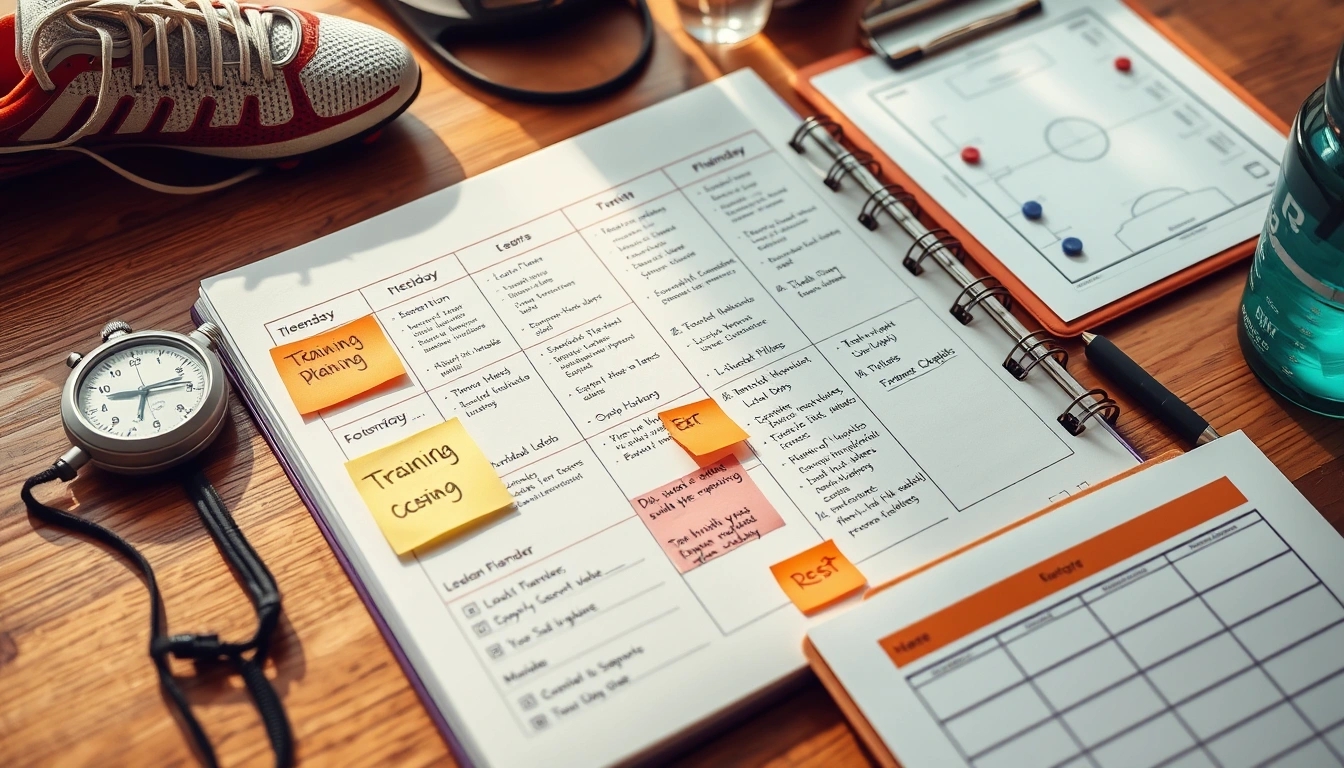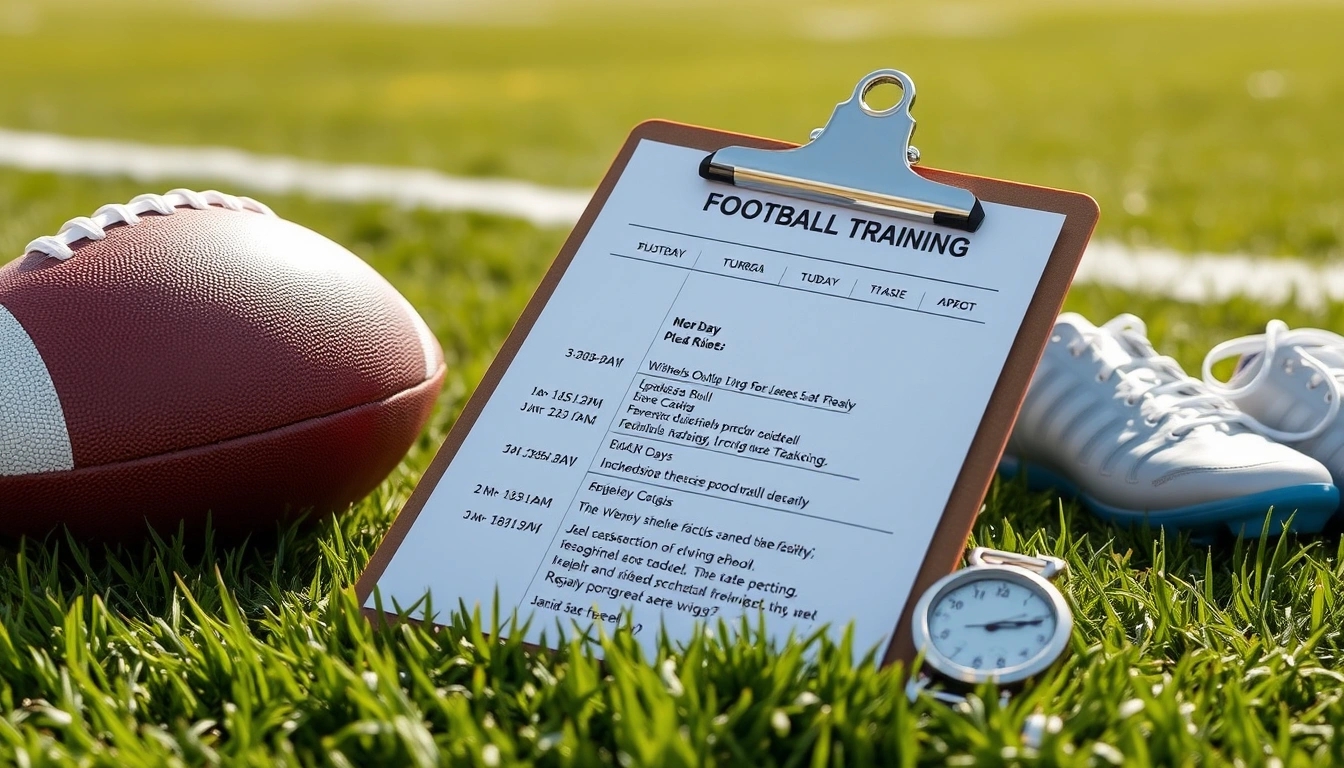Crafting a solid weekly football training plan isn’t just about showing up and kicking the ball around. Nah, it’s way more than that. If you want to actually boost your skills, fitness, and game-day performance, you’ve gotta get strategic. Think of it like building a sandwich: you need the right layers, or else it’s just a sad, soggy mess. So, buckle up, because we’re about to break down how to build a routine that actually works — no fluff, just real talk.
Assessing Your Current Fitness Level
Before you go all-in, take a moment to figure out where you stand physically. This means no guessing games — be honest. Are you gasping after a 5-minute jog? Or can you sprint like a cheetah on Red Bull? Knowing this helps you avoid the classic rookie mistake: biting off more than you can chew and ending up injured or burned out. A quick checklist might help:
- Endurance test: How long can you run without stopping?
- Speed check: Time your 40-meter sprint.
- Agility drill: Can you weave through cones without tripping?
Setting Realistic Goals
Goals are like your GPS — without them, you’re just wandering aimlessly. But here’s the catch: your goals gotta be realistic. Wanting to be the next Messi overnight? Dream on. Instead, aim for stuff like improving your sprint time by 0.5 seconds or mastering a new dribbling move each week. Keep it measurable and achievable, so you don’t lose steam.
| Goal Type | Example | Why It Matters |
|---|---|---|
| Speed | Cut 0.3 seconds off 40m sprint | Faster players create more scoring chances |
| Stamina | Run 5km without stopping | Endurance keeps you sharp late in games |
| Technical Skill | Master 3 new dribbling moves | Better ball control more confidence |
Structuring Your Week: Balancing Training and Rest
Here’s where most folks mess up — either they train like maniacs every day or slack off too much. The trick is balance. You want to push hard but also give your body a breather. Think of your week like a rollercoaster: some days you’re climbing (high-intensity), and other days you’re coasting down (rest and recovery).
High-Intensity Training Days
These are your “go hard or go home” sessions. Focus on sprint drills, tactical plays, and explosive movements. It’s tough, no sugar-coating it, but these days build your game awareness and power.
Recovery and Light Training Days
Recovery doesn’t mean Netflix and chill (well, maybe a bit). It’s about light jogging, stretching, yoga, or foam rolling. These activities keep your muscles loose and ready to smash the next hard session.
Incorporating Strength and Conditioning
Football isn’t just about fancy footwork — it’s a physical game. Strength training builds resilience, helps prevent injuries, and makes you tougher on the pitch. Don’t skip it! Think squats, lunges, and core workouts.
Nutrition and Hydration Tips
You can train like a beast, but if you’re eating junk and forgetting water, it’s all downhill. Fuel your body with balanced meals — carbs for energy, protein for muscle repair, and fats for stamina. And gulp that water like your life depends on it.
Tracking Progress and Adjusting the Routine
Keep a journal or use an app to log your workouts and improvements. If something isn’t working, tweak it. Maybe you need more rest or a different drill. Don’t be stubborn.
Common Mistakes to Avoid
- Skipping rest days — your body needs them!
- Overtraining — more isn’t always better.
- Ignoring nutrition — you can’t outrun a bad diet.
- Neglecting warm-ups and cool-downs — injuries lurk here.
So, there you have it. Building a weekly football training routine isn’t rocket science, but it does require some planning, honesty, and a bit of grit. Keep it balanced, listen to your body, and most importantly, enjoy the process. After all, football’s meant to be fun — even when you’re sweating buckets.
Assessing Your Current Fitness Level
Before you lace up those boots and hit the pitch, it’s absolutely crucial to get a grip on where your body stands right now. Seriously, jumping headfirst into a grueling football training routine without knowing your physical baseline is like trying to score a goal blindfolded—risky and often painful. You want to tailor your workouts smartly, dodge those pesky injuries, and not end up burnt out by midweek. So, let’s break down how you can size yourself up effectively.
First off, don’t just guess or rely on how you *feel*—because, let’s be honest, sometimes you think you’re fitter than you actually are (been there, done that). Instead, start with some basic fitness tests that cover the essentials: endurance, strength, speed, and flexibility. Here’s a quick rundown:
| Fitness Component | Test Example | What It Tells You |
|---|---|---|
| Endurance | Yo-Yo Intermittent Recovery Test or 12-minute Cooper Run | How long you can keep moving without gasping for air |
| Strength | Max reps of push-ups or squats in 1 minute | Muscle power and endurance |
| Speed | 30-meter sprint | Your explosive quickness |
| Flexibility | Sit and reach test | Range of motion, injury prevention |
Now, don’t freak out if your numbers aren’t jaw-dropping at first. The whole point is to know where you’re starting so you can build up gradually. Overestimating yourself is a classic rookie mistake and a fast track to pulled muscles or worse. Trust me, the grass isn’t greener on the other side if you’re sidelined with an injury!
Another thing to consider: body composition. Yeah, that means not just weight but how much of it is muscle versus fat. A quick way to check is using skinfold calipers or bioelectrical impedance scales if you have access to them. These numbers help you understand if you need to bulk up, slim down, or simply maintain. It’s a bit of a balancing act, but knowing this info upfront lets you tweak your training and diet accordingly.
- Pro Tip: Keep a fitness journal or app to log these tests and your feelings after workouts. It’s amazing how tracking progress keeps you honest and motivated.
- Don’t Skip Warm-Ups: Assessing fitness isn’t just about raw numbers; how your body reacts to warm-ups and cool-downs says a lot about your readiness.
- Listen to Your Body: If you feel unusually tired or sore during tests, it might be a sign you need rest or medical check-up before pushing further.
In the end, assessing your current fitness level is less about scoring perfect marks and more about being brutally honest with yourself. It’s the foundation for a smart, sustainable football training routine that actually makes you better without breaking you. So take a deep breath, grab a stopwatch, and start measuring—you’ll thank yourself later.
Setting Realistic Goals
Let’s get real for a second: setting goals isn’t just scribbling down “become the next Messi” on a napkin and calling it a day. Nope, it’s way more practical—and honestly, way more rewarding—when you break it down into clear, doable steps that actually make sense for your current level. If you go too wild with your ambitions, you’re just setting yourself up for frustration, burnout, or worse, quitting altogether. So, start by asking yourself: where am I now, and where do I want to be in, say, a month or two?
Why bother with realistic goals? Because they’re the fuel that keeps your motivation engine running. Imagine trying to sprint a marathon without training—sounds crazy, right? Same thing with football skills and fitness. When goals are achievable, every little win feels like a legit victory. You get to measure progress, tweak your routine, and keep that fire burning. Whether it’s shaving a few seconds off your 40-meter dash, boosting your stamina so you don’t gas out in the second half, or mastering a tricky tactical move, having a clear target keeps you focused.
| Type of Goal | Example | Why It Works |
|---|---|---|
| Speed | Cut your 100m sprint time by 0.5 seconds in 6 weeks | Specific, measurable, time-bound—keeps you laser-focused |
| Stamina | Run continuously for 30 minutes without feeling wiped out | Builds endurance gradually and realistically |
| Tactical Skills | Successfully execute 5 different passing drills flawlessly | Targets skill improvement with clear milestones |
Now, let’s be honest—sometimes goals need to be flexible. Life happens, injuries pop up, or maybe your motivation dips (we’ve all been there). Don’t beat yourself up if you need to adjust. The key is to keep your eyes on the prize but be kind to yourself along the way. It’s not about perfection; it’s about progress.
- Start small: Big goals are great, but break them into bite-sized chunks so you’re not overwhelmed.
- Keep it measurable: Vague goals like “get better” won’t cut it. How will you know you’re improving?
- Set deadlines: Without a timeline, goals can drag on forever and lose urgency.
Here’s a quick practical tip: write your goals down and keep them visible. Slap that list on your wall, phone, or locker. Seeing them daily reminds you what you’re working for—and trust me, when you’re dragging after a tough session, that little nudge can be a game changer.
Example of a Weekly Goal Plan:Monday: Improve sprint speed - 10x30m sprints with full restWednesday: Boost stamina - 20-minute continuous run at moderate paceFriday: Tactical drills - 30 minutes practicing passing and positioningSunday: Rest and recovery - light stretching and hydration focus
In the end, setting realistic goals isn’t just a checkbox on your training list—it’s the secret sauce that transforms hard work into real results. So, get cracking, keep it honest, and watch yourself level up week after week. No magic wand needed, just smart planning and a bit of grit.

Structuring Your Week: Balancing Training and Rest
Alright, let’s get real for a second — if you think smashing yourself with back-to-back brutal football sessions every single day is gonna make you the next Messi, think again. Finding that sweet spot between intense training and giving your body some well-deserved downtime is like the secret sauce to not just surviving, but thriving on the pitch.
Here’s the deal: your muscles, joints, and even your brain need time to recover. Overdo it, and you’re flirting with burnout, injuries, or worse — losing that fire and passion you started with. Trust me, nobody wants to be the guy who’s always limping or looking drained on game day.
- Intense Sessions: These are your days for pushing limits — think sprints, tactical drills, scrimmages. You want to hit these hard, but not so often that your body throws in the towel.
- Recovery Days: Not just “Netflix and chill,” but active recovery — light jogging, stretching, maybe some yoga. Keeps the blood flowing without beating you up.
| Day | Focus | Intensity |
|---|---|---|
| Monday | High-intensity drills & sprints | High |
| Tuesday | Light jog & stretching | Low |
| Wednesday | Tactical plays & ball handling | Medium-High |
| Thursday | Yoga & mobility work | Low |
| Friday | Game simulation & conditioning | High |
| Saturday | Rest or active recovery | Low |
| Sunday | Rest | None |
Now, you might be thinking, “But I want to train every day! No pain, no gain, right?” Sure, I get the hustle, but there’s a fine line between grinding and wrecking yourself. Your body’s gotta rebuild stronger — that’s where rest comes in. Think of it like charging your phone: you wouldn’t run it 24/7 without plugging it in, would you?
One sneaky mistake many players make is ignoring the signs of overtraining — nagging soreness, constant fatigue, or that annoying dip in performance. Instead of pushing through, listen to your body. If you’re feeling wiped out, dial it back. It’s not weakness; it’s smart training.
- Pro Tip: Mix up your training intensity throughout the week to keep things fresh and avoid plateaus.
- Don’t skip recovery: Active rest days actually help flush out toxins and reduce muscle stiffness.
- Sleep matters: Never underestimate the power of a good night’s sleep in your recovery game.
In the end, balancing training and rest isn’t just about avoiding injury — it’s about making every session count. You want to roll onto the pitch feeling pumped and ready, not like you just ran a marathon (unless that’s your game plan, then hey, go for it!). So, map out your week wisely, respect your body’s limits, and watch your performance skyrocket.
High-Intensity Training Days
— oh boy, these are the sessions where sweat meets grit and you either love it or hate it, sometimes both at once. Imagine this: you’re out on the field, heart pounding, legs burning, and your coach yelling, “Push harder!” These days aren’t just about running aimlessly around the pitch; they’re meticulously designed to crank up your explosiveness, sharpen your tactical brain, and get you ready for those split-second decisions that make or break a game.
- Drills: Forget the boring, repetitive stuff you might think of. We’re talking about drills that challenge your coordination, reaction time, and ball control under pressure. Picture rapid-fire passing sequences, tight cone maneuvers, and one-on-one duels that simulate real-game chaos.
- Sprints: Not your casual jogs. These are all-out, full-throttle bursts over short distances designed to boost your acceleration and top-end speed. Think 10 to 40-meter sprints with minimal rest, leaving your lungs gasping and legs screaming.
- Tactical Plays: This is where your brain gets a workout. Running through various formations, practicing set pieces, and rehearsing attacking or defensive strategies. It’s like chess but with sweat and mud.
| Component | Purpose | Typical Duration |
|---|---|---|
| Explosive Drills | Enhance agility and ball control under pressure | 20-30 minutes |
| Sprint Intervals | Improve acceleration and anaerobic endurance | 15-20 minutes |
| Tactical Practice | Boost game awareness and decision-making | 25-35 minutes |
Now, don’t get me wrong — these sessions can be brutal. You’ll feel like you’ve been hit by a truck by the end, but that’s the point. It’s about pushing your limits, breaking through mental and physical barriers. Plus, there’s a sneaky little bonus: the more you do this, the more your body adapts. Your muscles start firing faster, your lungs get tougher, and your mind sharpens like a razor.
One thing to keep in mind — these days are not for the faint-hearted or the “I’ll just take it easy” crowd. You gotta bring your A-game, or you’re just wasting time. But hey, if you’re the type who thrives on challenge and loves that post-session high (even if you’re hobbling the next day), this is your playground.
Pro tip: Mix up your drills to keep things fresh. If you do the same sprint routine every week, your body gets bored, and so does your brain. Switch between hill sprints, shuttle runs, or even resistance sprints with a parachute or sled. Variety keeps your muscles guessing and your motivation up.
Lastly, remember that high-intensity training isn’t just about raw power or speed. It’s also about learning to read the game better. The tactical drills? They’re your secret weapon. When you’re exhausted, your mind can fog over, but with enough practice, those smart plays become second nature. You’ll start anticipating opponents’ moves and making split-second decisions like a seasoned pro.
So, yeah, high-intensity days are tough, but they’re where the magic happens. If you want to be faster, smarter, and tougher on the field, these sessions are non-negotiable. Just don’t forget to recover properly afterward — your muscles will thank you later (or else they’ll remind you with a painful ache).
Keep grinding, and remember: no pain, no gain — but maybe a little fun in between!
Recovery and Light Training Days
Alright, let’s get real about recovery days in football training—they’re not just about vegging out on the couch binge-watching your favorite series (tempting as that sounds). Recovery is an active process, and if you’re serious about leveling up your game, you gotta treat these days with respect. Think of them as the secret sauce that keeps your muscles happy and your body ready to smash those intense sessions when they roll around.
First off, light jogging is a classic move. It’s not about setting a new personal best or sprinting like you’re being chased by a swarm of bees. Nope, it’s all about gentle movement to get the blood flowing without stressing your body. This kind of easy-paced jog helps flush out lactic acid and reduces muscle stiffness. Plus, it’s a great way to keep your cardiovascular system ticking over without going full throttle.
Now, stretching—don’t roll your eyes just yet! I know it sounds like something your grandma would nag you about, but proper stretching after a workout or on recovery days can save you from a world of pain later. Dynamic stretches in the warm-up and static stretches during cool-down help maintain flexibility and prevent those annoying muscle pulls. And when you’re dealing with football, where quick direction changes are the norm, flexibility is your best friend.
| Recovery Activity | Purpose | Duration |
|---|---|---|
| Light Jogging | Promotes blood flow, reduces muscle soreness | 15-30 minutes |
| Stretching | Enhances flexibility, prevents injuries | 10-20 minutes |
| Yoga | Improves balance, relaxation, and muscle elongation | 20-40 minutes |
Speaking of yoga, it’s not just some hippy-dippy stretch fest. Yoga can be a game changer for footballers. It improves your balance, core strength, and mental focus—all crucial when you’re darting around the pitch trying to dodge defenders or nail that perfect pass. Plus, it encourages mindful breathing and relaxation, which can help calm those pre-match jitters or post-training aches.
- Pro Tip: Incorporate breathing exercises during yoga to reduce stress hormones and speed recovery.
- Don’t Skip: Even on recovery days, keep moving—complete rest can sometimes backfire and make you feel stiffer.
- Listen to Your Body: If you’re feeling extra sore or fatigued, dial down the intensity or swap jogging for a brisk walk.
Remember, these light training days are about preparing your body for the next big push, not about pushing yourself to the brink. Skipping recovery or treating it as a free-for-all rest day can actually slow your progress and increase injury risk. So, next time you think about blowing off your light session, just picture your muscles waving little flags asking for mercy—and then get out there and treat them right.
In short: recovery days are your unsung heroes. They keep you fresh, flexible, and firing on all cylinders when it really counts. Don’t underestimate the power of a slow jog, a good stretch, or a calming yoga flow. Your future self (and your hamstrings) will thank you.
Incorporating Strength and Conditioning
Football isn’t just about fancy footwork or nailing that perfect pass. Nope, behind every jaw-dropping goal or bone-crunching tackle lies a foundation of solid strength and conditioning. It’s the unsung hero of the game, building up your resilience, slashing the chances of injury, and cranking your overall performance up a notch (or ten). Let’s break down why this stuff is a game-changer and how you can sneak it into your weekly routine without losing your mind.
First off, strength training isn’t just about bulking up like a linebacker. It’s about functional power — the kind that helps you explode off the line, hold your ground against a charging opponent, and recover quickly after a sprint. Conditioning, meanwhile, is the stamina side of things. Think: running up and down the pitch for 90 minutes without feeling like you just ran a marathon in a sauna. Without both working in harmony, you’re just half-prepared — like showing up to a gunfight with a knife.
- Why Strength Matters: It fortifies muscles, ligaments, and tendons, making you less prone to pulls and tears.
- Why Conditioning Counts: It boosts your cardiovascular endurance, so you don’t gas out halfway through the second half.
Now, don’t get me wrong — you can’t just hit the weights and call it a day. Smart programming is key. Overdoing it? That’s a fast track to burnout or worse, sidelining injuries. Underdoing it? Well, you might as well be playing dodgeball instead of football.
| Day | Focus | Example Exercises |
|---|---|---|
| Monday | Strength (Lower Body) | Squats, Deadlifts, Lunges |
| Wednesday | Conditioning | Interval Sprints, Agility Drills |
| Friday | Strength (Upper Body) | Push-Ups, Pull-Ups, Bench Press |
| Saturday | Recovery & Mobility | Yoga, Light Jog, Stretching |
One thing that often flies under the radar? Core strength. It’s the glue holding everything together — balance, posture, power transfer — all wrapped up in your midsection. A weak core is like trying to build a house on sand. So, toss in planks, Russian twists, and leg raises to your plan.
Don’t forget, strength and conditioning aren’t static. As you get fitter and stronger, your routine should evolve. Track your progress, celebrate small wins, but also be ready to shake things up when you hit a plateau. And hey, listen to your body — if it’s screaming for rest, it’s probably not just being dramatic.
In short, incorporating strength and conditioning into your football training isn’t optional if you want to play hard and play long. It’s the secret sauce that turns potential into performance. So, lace up, hit the gym (or the field), and get ready to surprise even yourself.
Nutrition and Hydration Tips
Fueling your body right? Oh, that’s not just some fancy phrase coaches throw around to sound smart. It’s actually half the battle when it comes to football training. You can grind it out on the field all day, but if your nutrition and hydration game is weak, you’re basically running on empty. And trust me, no one wants to be that guy who crumbles in the last quarter because they forgot to drink water or eat a decent meal.
Let’s get real — your muscles need more than just water and a protein shake. They crave a balance of carbs, proteins, fats, vitamins, and minerals. Carbs are your main energy source, so don’t skip on those pasta nights or oatmeal mornings. Proteins? They’re the building blocks for muscle repair and growth, so chicken, fish, beans, or even that guilty pleasure of a peanut butter sandwich can be your best friends. Fats get a bad rap sometimes, but healthy fats like avocados and nuts help with inflammation and keep your brain sharp on the field.
- Pre-Training Fuel: Aim for a meal or snack rich in carbs and moderate protein about 1.5 to 2 hours before hitting the field. Think banana with peanut butter or a turkey sandwich.
- During Training: Hydration is king here. Sip water consistently, and if you’re sweating buckets in a long session, a sports drink with electrolytes can save you from cramping up.
- Post-Training Recovery: This is where the magic happens. Refuel with a combo of carbs and protein within 30 minutes to help muscles bounce back quicker.
| Meal | Main Focus | Example Foods |
|---|---|---|
| Breakfast | Carbs + Protein | Oatmeal, eggs, fruit |
| Lunch | Balanced Meal | Grilled chicken, quinoa, veggies |
| Snack | Quick Energy | Yogurt, nuts, banana |
| Dinner | Protein + Veggies | Salmon, sweet potatoes, salad |
Now, hydration — let’s not kid ourselves, chugging water only when you’re parched is a rookie mistake. You gotta be on top of your fluid intake all day long. Dehydration sneaks up on you, and suddenly your legs feel like jelly, and your focus? Poof, gone. A good rule of thumb is to drink about half your body weight in ounces of water daily. So, if you’re 180 pounds, that’s roughly 90 ounces. Sounds like a lot? Well, tough luck, champ, it’s necessary.
Also, keep an eye on what you drink — sodas, energy drinks, and too much caffeine can dehydrate you more than hydrate. And if you’re sweating buckets in hot weather or during intense drills, sports drinks with electrolytes can help replace lost sodium and potassium, but don’t go overboard or you’ll be gulping sugar instead of water.
Tips for Staying Hydrated:- Start your day with a glass of water.- Carry a water bottle everywhere.- Drink small amounts regularly instead of big gulps sporadically.- Add a slice of lemon or cucumber for flavor if plain water bores you.
At the end of the day, nutrition and hydration aren’t glamorous topics like scoring goals or making tackles, but they’re the unsung heroes behind every athlete’s success. Ignore them, and your training might just hit a wall. So, eat smart, drink smart, and watch how much sharper and stronger you feel on the pitch. No magic pills here, just good old-fashioned fuel and fluids.
Remember: Your body is your machine. Treat it well, and it’ll carry you through those grueling 90 minutes and beyond.

Tracking Progress and Adjusting the Routine
Alright, let’s get real for a moment—sticking to a football training routine is one thing, but keeping track of your progress and making changes? That’s where most folks tend to slack off or get stuck. You might be grinding hard every week, but if you’re not checking in on how you’re actually improving, you could be spinning your wheels without even realizing it. And trust me, nobody wants to hit that dreaded plateau where gains just flatline.
So, what’s the secret sauce? Regular monitoring. This doesn’t mean you have to become a stats geek overnight, but jotting down your performance, how you feel after workouts, and any new personal bests can be a game-changer. For example, keep a simple log—maybe a notebook or an app—where you note sprint times, number of successful passes, or how long you lasted in endurance drills. This way, you get a clear snapshot of where you started, and more importantly, where you’re headed.
| What to Track | Why It Matters | How Often |
|---|---|---|
| Sprint times | Measures speed and explosiveness | Weekly |
| Endurance levels | Shows stamina improvements | Bi-weekly |
| Skill drills success rate | Tracks tactical progress | After each session |
| Recovery quality | Prevents burnout and injury | Daily |
Now, here’s the catch: adjusting your routine isn’t just about adding more reps or running longer. Nope, it’s about smart tweaks. If you notice your sprint times plateauing, maybe it’s time to switch up your drills or add some resistance training. Feeling wiped out all the time? That’s a neon sign screaming for more rest or lighter sessions. And hey, don’t be afraid to shuffle your schedule around—sometimes a mid-week recovery day instead of a weekend one can make all the difference.
- Be flexible: The best plans aren’t set in stone.
- Listen to your body: Soreness vs. pain is a big deal.
- Celebrate small wins: Progress isn’t always huge leaps.
One more thing—don’t let numbers rule your mood. It’s tempting to get obsessed with every little stat, but sometimes the progress is more subtle. Maybe you feel more confident on the pitch or your decision-making speeds up. Those are wins too, even if they don’t show up on a stopwatch.
In the end, tracking and tweaking your football training routine is like tuning a race car. You gotta keep an eye on the gauges and adjust the engine to keep it running smooth and fast. Ignore it, and well… you might just stall out. So, keep at it, stay curious about your progress, and don’t be afraid to shake things up. Your future self (and your coach) will thank you.
Common Mistakes to Avoid
When you’re fired up about football training, it’s easy to fall into traps that can actually hold you back instead of pushing you forward. Let’s be honest, nobody wants to waste all those sweat-drenched hours only to see minimal progress or, worse, get sidelined by injury. So, here’s the lowdown on the usual suspects you need to dodge like a pro defender.
1. Skipping Rest Days
You might think, “More training faster improvement,” but that’s a rookie mistake. Your body isn’t a machine; it needs downtime to repair muscles and recharge energy stores. Ignoring rest days is like trying to run a marathon on an empty tank — disaster waiting to happen. Over time, this leads to fatigue, decreased performance, and a higher risk of injury. So, pencil in those recovery days like they’re non-negotiable meetings.
2. Overtraining Without Listening to Your Body
Pushing limits is part of the game, but overtraining is a sneaky villain. Signs like persistent soreness, irritability, and poor sleep shouldn’t be brushed off. If you’re feeling wiped out or just “off,” it’s your body waving a red flag. Ignoring these signals can cause burnout or chronic injuries. Remember, smart training beats mindless grinding every time.
| Common Mistake | Impact | How to Avoid |
|---|---|---|
| Neglecting Rest | Fatigue, injury risk, poor performance | Schedule regular rest days and active recovery |
| Overtraining | Burnout, chronic soreness, mental fatigue | Listen to your body, adjust intensity |
| Poor Nutrition | Low energy, slower recovery, weakened immunity | Eat balanced meals, hydrate well |
3. Ignoring Nutrition and Hydration
You can’t out-train a bad diet. Seriously. If you’re fueling up on junk or skipping meals, your body won’t have the energy to sustain intense training sessions or recover properly. Dehydration? Even worse. It messes with your focus, endurance, and muscle function. So, think of nutrition as your secret weapon — carbs for energy, protein for muscle repair, and plenty of water to keep everything running smoothly.
- Tip: Prep your meals ahead of time. When hunger hits, you won’t be tempted by whatever’s quick and easy but terrible for you.
- Tip: Keep a water bottle handy. Sip throughout the day, not just when you’re parched.
4. Skipping Warm-Ups and Cool-Downs
Skipping these is like jumping into a cold pool – shock to the system! A proper warm-up preps your muscles and joints, reducing injury risk. Cool-downs help flush out lactic acid and ease muscle stiffness. Don’t be that guy who rushes through or skips these parts because “they’re boring.” They’re boring for a reason — they work.
5. Setting Unrealistic Goals
We all want to be the next big star overnight, but setting goals that are too lofty can crush your motivation when progress stalls. Break your ambitions into smaller, achievable steps. Celebrate the small wins — they add up and keep the fire burning.
Practical Checklist to Avoid Pitfalls:- Schedule at least 1-2 rest days weekly- Monitor fatigue and mood daily- Eat balanced meals, focusing on whole foods- Hydrate consistently throughout the day- Always warm up and cool down- Set SMART (Specific, Measurable, Achievable, Relevant, Time-bound) goals
In the end, the secret sauce to a killer football training routine isn’t just grinding harder — it’s training smarter. Watch out for these common mistakes, and you’ll keep your progress on track without burning out or sidelining yourself. Trust me, your future self on game day will thank you.
Frequently Asked Questions
- How do I know if my fitness level is good enough to start a football training routine?
Great question! Before kicking off your training, it’s smart to assess your current fitness. Think of it like checking the gas gauge before a road trip—you want to know how far you can go without running out of steam. Simple tests like timing your sprints, measuring endurance with a jog, or even consulting a fitness professional can give you a clear picture. This helps you avoid overdoing it and keeps your progress steady and safe.
- What’s the best way to set realistic goals for my football training?
Setting goals is like plotting your route on a map—it guides your journey and keeps you motivated. Start by identifying what you want to improve: speed, stamina, or maybe tactical skills. Then, break those big ambitions into smaller, achievable milestones. For example, shaving a second off your sprint time or mastering a new dribbling move each week. This keeps things exciting and lets you celebrate wins along the way.
- How should I balance intense training with rest days?
Imagine your body as a high-performance engine—it needs both fuel and downtime. High-intensity days push your limits with sprints and drills, but recovery days are equally important. Light jogs, stretching, or yoga can help your muscles relax and rebuild stronger. Striking this balance prevents burnout and keeps you fresh for game day.
- Why is strength and conditioning important for football players?
Think of strength and conditioning as the secret sauce that boosts your game. It’s not just about looking strong—it builds resilience, helps prevent injuries, and improves your overall performance on the pitch. Incorporating weight training, plyometrics, and core exercises can turn you into a powerhouse ready for any challenge.
- What nutrition and hydration tips should I follow during training?
Fueling your body properly is like topping up your tank with premium fuel. Eating balanced meals rich in proteins, carbs, and healthy fats gives you the energy to train hard and recover fast. Don’t forget hydration—water keeps your engine running smoothly, especially during intense workouts. Aim to drink consistently throughout the day, not just when you’re thirsty.
- How can I track my progress effectively?
Tracking progress is like keeping a scorecard for your personal growth. Use a training journal or apps to log your workouts, times, and how you feel after sessions. Regular check-ins help you spot improvements and tweak your routine if you hit a plateau. It’s all about staying on track and making your hard work count.
- What common mistakes should I avoid in my football training routine?
Watch out for the classic traps! Skipping rest days, pushing too hard without proper recovery, or ignoring nutrition can derail your progress faster than you think. Also, don’t neglect warming up or cooling down—they’re your body’s best friends for avoiding injury. Keep your routine balanced and listen to your body’s signals.











